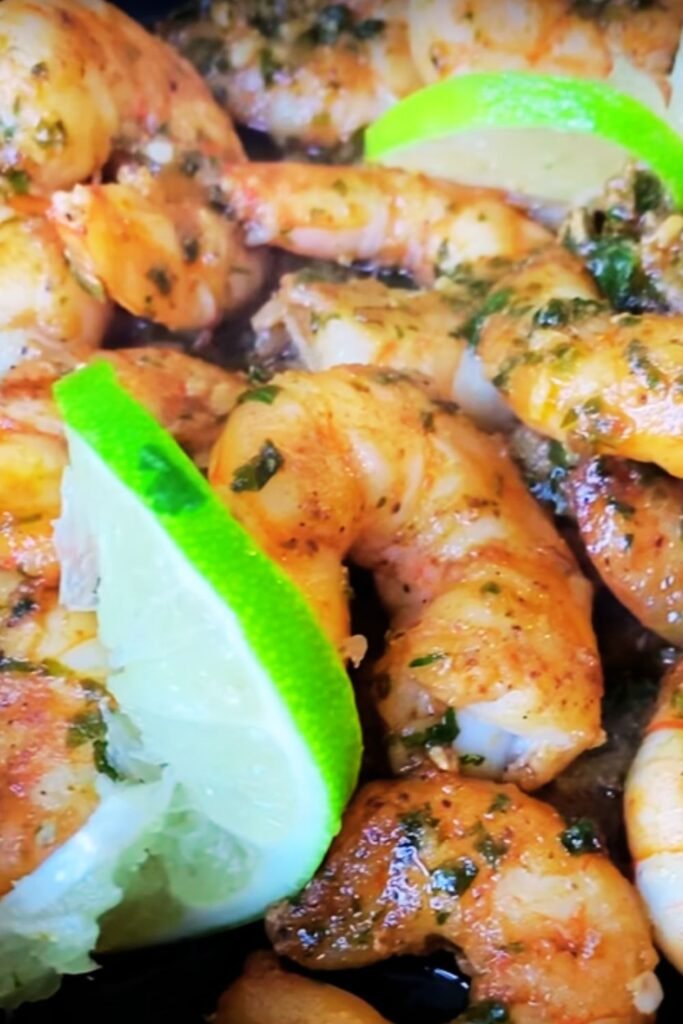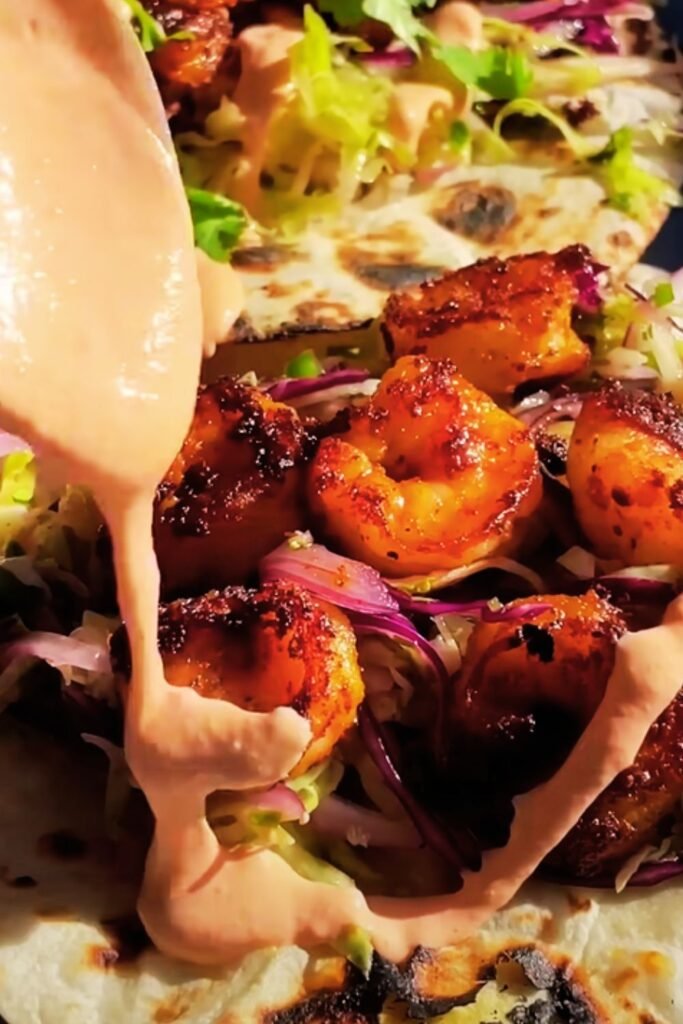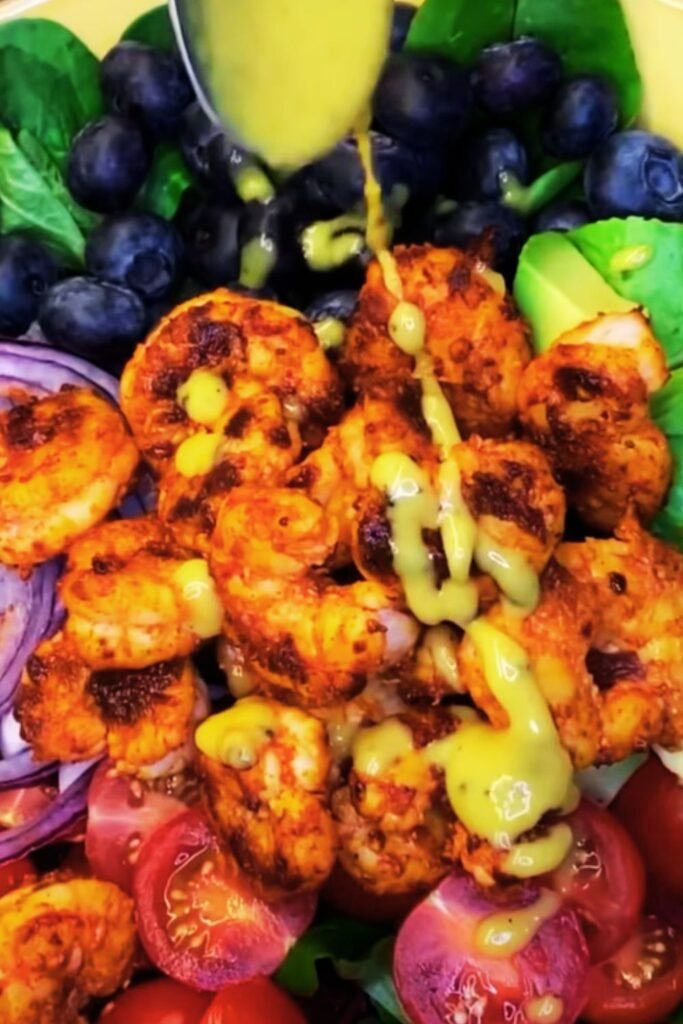I’ve been experimenting with fresh, vibrant salads for years, and this cilantro salad with shallots and shrimp has become one of my absolute favorites. The combination of aromatic cilantro, sweet shallots, and succulent shrimp creates a symphony of flavors that’s both refreshing and satisfying. This isn’t just another salad recipe – it’s a complete meal that brings together the best of fresh herbs, seafood, and simple preparation techniques.
What makes this dish truly special is how the cilantro takes center stage rather than playing a supporting role. Many people think of cilantro as merely a garnish, but in this recipe, it becomes the star ingredient that ties everything together. The peppery bite of fresh cilantro pairs beautifully with the mild sweetness of properly cooked shrimp, while the shallots add a subtle onion flavor that’s more refined than regular onions.
Understanding the Key Ingredients
Cilantro (Coriandrum sativum) : A bright green herb with a distinctive flavor that’s both citrusy and slightly peppery. Rich in vitamins A, C, and K, plus antioxidants that support overall health.
Shallots (Allium cepa var. aggregatum) : Small, elongated onions with a milder, sweeter flavor than regular onions. They contain compounds that may help reduce inflammation and support heart health.
Shrimp (Various species) : Low-calorie, high-protein seafood that’s rich in selenium, vitamin B12, and omega-3 fatty acids. The key is choosing fresh, sustainably sourced shrimp.
Lime Juice : Essential for brightening the entire dish while providing vitamin C and helping to preserve the vibrant green color of the cilantro.
I’ve found that the quality of your ingredients makes an enormous difference in this recipe. When I use fresh, organic cilantro from my local farmer’s market, the flavor is incomparably better than store-bought herbs that have been sitting around for days. The same goes for the shrimp – I always opt for fresh or flash-frozen varieties over pre-cooked options.
Essential Equipment and Preparation
Before diving into the cooking process, let me share the essential equipment that will make your preparation smoother and more enjoyable:
- Large mixing bowl for combining ingredients
- Sharp chef’s knife for precise cutting
- Cutting board (preferably wooden for herbs)
- Medium saucepan for cooking shrimp
- Fine-mesh strainer for rinsing
- Citrus juicer or reamer
- Measuring cups and spoons
- Salad serving utensils
The preparation technique is crucial for achieving the perfect texture and flavor balance. I’ve learned through trial and error that the way you handle each ingredient significantly impacts the final result. For instance, cilantro should be washed gently and patted dry completely before chopping, as excess moisture can make the salad soggy.

Complete Recipe Instructions
Ingredients List
| Ingredient | Quantity | Notes |
|---|---|---|
| Fresh cilantro | 4 cups, roughly chopped | Use only the leaves and tender stems |
| Medium shrimp | 1 pound, peeled and deveined | 31-40 count works best |
| Shallots | 3 medium, thinly sliced | Can substitute with red onion if needed |
| Lime juice | 1/4 cup, freshly squeezed | About 2-3 large limes |
| Extra virgin olive oil | 3 tablespoons | Use high-quality oil for best flavor |
| Sea salt | 1 teaspoon | Adjust to taste |
| Black pepper | 1/2 teaspoon, freshly ground | White pepper also works |
| Garlic | 2 cloves, minced | Fresh garlic is essential |
| Red pepper flakes | 1/4 teaspoon | Optional, for heat |
| Cucumber | 1 medium, diced | Adds crunch and freshness |
| Cherry tomatoes | 1 cup, halved | Choose firm, ripe tomatoes |
Step-by-Step Preparation
Step 1: Prepare the Shrimp Begin by bringing a large pot of salted water to boil. While waiting, I like to prepare an ice bath in a large bowl – this will stop the cooking process immediately and ensure perfectly tender shrimp. Add the shrimp to the boiling water and cook for exactly 2-3 minutes, depending on size. The shrimp should turn pink and curl slightly. Immediately transfer to the ice bath using a slotted spoon.
Step 2: Prepare the Vegetables While the shrimp cools, slice the shallots as thinly as possible. I prefer using a sharp knife rather than a mandoline for better control. The key is achieving uniform, paper-thin slices that will distribute evenly throughout the salad. Dice the cucumber into small, bite-sized pieces, and halve the cherry tomatoes.
Step 3: Prepare the Cilantro Wash the cilantro thoroughly in cold water, swishing it around to remove any dirt or debris. Pat completely dry with paper towels or use a salad spinner. Remove the thick stems, keeping only the leaves and tender stems. Roughly chop the cilantro – you don’t want it too fine, as larger pieces provide better texture and flavor bursts.
Step 4: Create the Dressing In a small bowl, whisk together the lime juice, olive oil, minced garlic, salt, pepper, and red pepper flakes if using. I always taste the dressing at this stage and adjust the seasoning as needed. The dressing should be bright and tangy with a good balance of acidity and richness.
Step 5: Assemble the Salad In your large mixing bowl, combine the cooled shrimp, sliced shallots, chopped cilantro, diced cucumber, and halved cherry tomatoes. Pour the dressing over the mixture and toss gently but thoroughly. I use clean hands for this step, as it allows me to distribute the dressing more evenly without crushing the delicate ingredients.

Nutritional Information and Health Benefits
This cilantro salad with shallots and shrimp isn’t just delicious – it’s also incredibly nutritious. I’ve calculated the approximate nutritional values per serving, assuming the recipe serves four people:
| Nutrient | Per Serving | Daily Value % |
|---|---|---|
| Calories | 245 | 12% |
| Protein | 28g | 56% |
| Carbohydrates | 8g | 3% |
| Fat | 12g | 18% |
| Fiber | 2g | 8% |
| Vitamin C | 45mg | 75% |
| Vitamin A | 1200 IU | 24% |
| Folate | 85mcg | 21% |
| Selenium | 42mcg | 76% |
| Omega-3 fatty acids | 0.3g | N/A |
The health benefits of this dish are impressive. Cilantro is packed with antioxidants that help fight inflammation and may support heart health. The herb also contains compounds that may help with heavy metal detoxification, though I always recommend consulting with healthcare professionals for specific health concerns.
Shrimp provides high-quality protein with all essential amino acids, making this salad an excellent choice for those looking to increase their protein intake. The selenium content is particularly noteworthy, as this mineral supports thyroid function and acts as a powerful antioxidant.
Serving Suggestions and Variations
I’ve served this salad in numerous ways over the years, and each presentation brings out different aspects of the dish. Here are my favorite serving suggestions:
As a Light Lunch Serve the salad on its own with some crusty bread or pita chips. The combination of protein and fresh vegetables makes it satisfying without being heavy. I often prepare this for weekend lunches when I want something healthy but flavorful.
As a Starter Course Present smaller portions on individual plates as an elegant appetizer. Garnish with additional lime wedges and a sprinkle of toasted sesame seeds for extra visual appeal and texture.
With Grains Serve over quinoa, brown rice, or farro for a more substantial meal. The grains absorb the dressing beautifully and add fiber and complex carbohydrates to make the dish more filling.
In Lettuce Cups Use large butter lettuce leaves as cups for a low-carb presentation. This method is particularly popular at dinner parties, as guests can eat with their hands.

Flavor Variations and Substitutions
Over the years, I’ve experimented with numerous variations of this basic recipe. Each modification brings its own unique character while maintaining the essential fresh, bright flavors that make this salad special.
Asian-Inspired Version Add rice vinegar to the dressing along with a touch of sesame oil. Include thinly sliced radishes and replace the cherry tomatoes with diced mango for a tropical twist. A sprinkle of toasted sesame seeds adds wonderful texture and nutty flavor.
Mediterranean Twist Incorporate crumbled feta cheese and kalamata olives. Replace the lime juice with lemon juice and add a handful of fresh mint leaves alongside the cilantro. This version pairs beautifully with grilled vegetables.
Spicy Heat Version For those who enjoy more heat, add diced jalapeños or serrano peppers. I sometimes include a pinch of cayenne pepper in the dressing or use spicy olive oil. Fresh ginger, minced finely, also adds a wonderful warming element.
Protein Substitutions While shrimp is my preferred protein, this salad works wonderfully with other seafood. I’ve successfully used crab meat, lobster, or even cooked white fish like cod or halibut. For non-seafood options, grilled chicken or tofu can be substituted.
Storage and Make-Ahead Tips
One of the questions I get most frequently about this recipe is whether it can be made ahead of time. The answer is both yes and no, depending on how you approach it.
What You Can Prepare in Advance:
- Cook and chill the shrimp up to 24 hours ahead
- Prepare the dressing and store it separately
- Slice the shallots and store them in cold water
- Wash and chop the cilantro, storing it between damp paper towels
What Should Be Done Last Minute:
- Combining all ingredients should happen just before serving
- Adding the dressing should be the final step
- Dicing the cucumber and tomatoes is best done fresh
The reason I recommend assembling the salad just before serving is that the acid in the lime juice will start to break down the cilantro if left too long, causing it to lose its bright green color and fresh texture. However, if you need to prepare it completely ahead of time, the salad will still be delicious for up to 4 hours in the refrigerator.
Troubleshooting Common Issues
After making this recipe countless times and teaching it to friends and family, I’ve encountered and solved several common problems:
Problem: Shrimp becomes tough and rubbery Solution: This usually happens from overcooking. Shrimp should be cooked just until they turn pink and curl slightly. Remove them immediately and plunge into an ice bath to stop the cooking process.
Problem: Salad becomes watery Solution: This typically occurs when vegetables aren’t properly drained or when the salad sits too long after dressing. Always pat ingredients dry and dress just before serving.
Problem: Cilantro tastes too strong Solution: Some people are more sensitive to cilantro’s flavor. Try using less cilantro and adding more neutral greens like baby spinach or arugula to balance the taste.
Problem: Shallots are too sharp Solution: If raw shallots are too pungent, soak the sliced shallots in cold water for 10 minutes before using. This removes some of the sharp bite while maintaining their sweet flavor.
Seasonal Adaptations
I love how this recipe adapts to different seasons by incorporating seasonal produce. Each variation brings new flavors and textures while maintaining the core appeal of fresh cilantro and shrimp.
Spring Version In spring, I add fresh peas, snap peas, or sugar snap peas for sweetness and crunch. Fresh asparagus, blanched and chopped, also works wonderfully. The tender vegetables of spring complement the delicate flavors perfectly.
Summer Abundance Summer is when this salad truly shines. I incorporate whatever fresh vegetables are at their peak – corn kernels, diced bell peppers, or fresh berries for a surprising sweet element. Stone fruits like peaches or nectarines, diced small, add incredible flavor complexity.
Fall Harvest During fall, I sometimes add diced apples or pears for sweetness and crunch. Pomegranate seeds provide beautiful color and a tart burst of flavor. These additions work particularly well with the Asian-inspired variation.
Winter Warmth In winter, I focus on citrus additions – segments of orange or grapefruit add brightness when fresh summer vegetables aren’t available. Dried cranberries or chopped dates can provide sweetness, while toasted nuts add substance.
Wine and Beverage Pairings
The bright, fresh flavors of this cilantro salad pair beautifully with various beverages. I’ve found that the key is matching the lightness and acidity of the dish.
Non-Alcoholic Options Sparkling water with lime is my go-to pairing. The bubbles cleanse the palate between bites, while the lime echoes the dressing flavors. Fresh lemonade or limeade also works wonderfully, especially during hot summer days.
Iced green tea provides a subtle, refreshing complement that doesn’t compete with the salad’s delicate flavors. For something more substantial, fresh fruit juices like grapefruit or orange juice offer brightness that matches the salad’s energy.
Hot Beverages Surprisingly, light herbal teas can work well with this salad. Mint tea or chamomile provides a soothing contrast to the bright, acidic flavors. However, I typically reserve hot beverages for cooler weather when the salad is served as part of a larger meal.
Cultural Context and Recipe Origins
While this specific combination is my own creation, it draws inspiration from various culinary traditions that celebrate fresh herbs and seafood. Southeast Asian cuisines have long used cilantro as a main ingredient rather than just a garnish, and this recipe reflects that approach.
The technique of combining fresh herbs with seafood appears in many coastal cuisines around the world. From Thai som tam to Mediterranean seafood salads, the concept of letting fresh ingredients shine with minimal preparation is universal. My version takes these global influences and creates something that feels both familiar and new.
I developed this recipe during a particularly hot summer when I was craving something fresh and satisfying but didn’t want to turn on the oven. The combination came together almost by accident – I had beautiful cilantro from my garden, fresh shrimp from the market, and a desire to create something cooling and nutritious.
Questions and Answers
Q: Can I use frozen shrimp for this recipe? A: Absolutely! Frozen shrimp actually works very well for this recipe. Just make sure to thaw them completely and pat them dry before cooking. I often prefer frozen shrimp because they’re flash-frozen at peak freshness, which can mean better flavor than “fresh” shrimp that’s been sitting around.
Q: How long does this salad keep in the refrigerator? A: The salad is best consumed within 4-6 hours of preparation for optimal texture and color. However, it will remain safe to eat for up to 2 days. The cilantro may lose some of its bright green color, but the flavor will still be good.
Q: Can I substitute parsley for cilantro? A: While parsley can be substituted, it will create a completely different flavor profile. Cilantro has a unique citrusy, slightly peppery taste that’s central to this recipe. If you don’t enjoy cilantro, you might want to try a different salad recipe altogether.
Q: What size shrimp works best? A: I prefer medium to large shrimp (31-40 count per pound) because they provide good bite-sized pieces without being overwhelming. Smaller shrimp can get lost in the salad, while jumbo shrimp might be too large and dominate each bite.
Q: Can I make this salad spicier? A: Definitely! You can add more red pepper flakes, include diced jalapeños, or add a dash of hot sauce to the dressing. I sometimes include a pinch of cayenne pepper for heat that’s more evenly distributed throughout the salad.
Q: Is this salad suitable for meal prep? A: With some modifications, yes. Keep the components separate and assemble just before eating. The cooked shrimp, prepared vegetables, and dressing can all be stored separately for 2-3 days. This approach maintains the best texture and flavor.
Q: Can I serve this as a main course? A: Absolutely! The high protein content from the shrimp makes it substantial enough for a main course. I often serve it with some crusty bread or over grains like quinoa or rice to make it more filling.
Q: What if I can’t find shallots? A: Red onion is the best substitute, though it has a stronger flavor. Use about half the amount and consider soaking the sliced onion in cold water for 10 minutes to mellow the sharpness. Green onions can also work, using both white and green parts.
Q: Can I add other vegetables to this salad? A: Certainly! This recipe is quite flexible. Diced bell peppers, radishes, or even blanched green beans work well. Just be mindful of maintaining the balance of flavors and textures. I recommend adding no more than one or two additional vegetables to avoid overwhelming the cilantro and shrimp.
Q: How do I know when the shrimp are perfectly cooked? A: Perfectly cooked shrimp should be pink and opaque throughout, with a slight curl. They should feel firm but not tough. The cooking time is usually 2-3 minutes in boiling water, depending on size. Overcooked shrimp become rubbery and lose their sweet flavor.
This cilantro salad with shallots and shrimp has become a staple in my kitchen because it embodies everything I love about cooking: fresh ingredients, simple techniques, and bold flavors. Whether you’re looking for a light lunch, an elegant starter, or a healthy dinner option, this recipe delivers on all fronts. The combination of textures and flavors creates something truly special that I hope you’ll enjoy as much as I do.